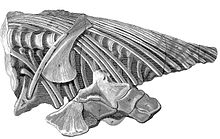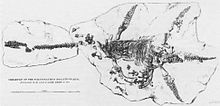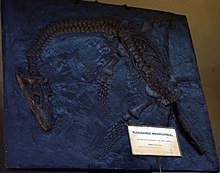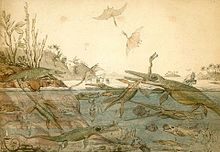Mary Anning
[2] Her father, Richard Anning (c. 1766–1810), was a cabinetmaker and carpenter who supplemented his income by mining the coastal cliff-side fossil beds near the town, and selling his finds to tourists; her mother was Mary Moore (c. 1764–1842) known as Molly.
[4] The incident was reported in the Bath Chronicle on 27 December 1798: "A child, four years of age of Mr. R. Anning, a cabinetmaker of Lyme, was left by the mother for about five minutes ... in a room where there were some shavings ...
Almost half the children born in the UK in the 19th century died before the age of five, and in the crowded living conditions of early 19th-century Lyme Regis, infant deaths from diseases like smallpox and measles were common.
[9] By the late 18th century, Lyme Regis had become a popular seaside resort, especially after 1792 when the outbreak of the French Revolutionary Wars made travel to the European mainland dangerous for the English gentry, and increasing numbers of wealthy and middle-class tourists were arriving there.
These were fossils with colourful local names such as "snake-stones" (ammonites), "devil's fingers" (belemnites), and "verteberries" (vertebrae), to which were sometimes attributed medicinal and mystical properties.
In the earlier nineteenth century, those who refused to subscribe to the Articles of the Church of England were still not allowed to study at Oxford or Cambridge or to take certain positions in the army, and were excluded by law from several professions.
He wrote to the palaeontologist Gideon Mantell on 5 March that year to say that the sale was "for the benefit of the poor woman and her son and daughter at Lyme, who have in truth found almost all the fine things which have been submitted to scientific investigation ...
In 1823, an article in The Bristol Mirror said of her: This persevering female has for years gone daily in search of fossil remains of importance at every tide, for many miles under the hanging cliffs at Lyme, whose fallen masses are her immediate object, as they alone contain these valuable relics of a former world, which must be snatched at the moment of their fall, at the continual risk of being crushed by the half suspended fragments they leave behind, or be left to be destroyed by the returning tide: – to her exertions we owe nearly all the fine specimens of Ichthyosauri of the great collections ...[20]The risks of Anning's profession were illustrated when in October 1833 she barely avoided being killed by a landslide that buried her black-and-white terrier, Tray, her constant companion when she went collecting.
Lady Harriet Silvester, the widow of the former Recorder of the City of London, visited Lyme in 1824 and described Anning in her diary: The extraordinary thing in this young woman is that she has made herself so thoroughly acquainted with the science that the moment she finds any bones she knows to what tribe they belong.
It is certainly a wonderful instance of divine favour—that this poor, ignorant girl should be so blessed, for by reading and application she has arrived to that degree of knowledge as to be in the habit of writing and talking with professors and other clever men on the subject, and they all acknowledge that she understands more of the science than anyone else in this kingdom.
[26] The king's physician and aide, Carl Gustav Carus, wrote in his journal: We had alighted from the carriage and were proceeding on foot, when we fell in with a shop in which the most remarkable petrifications and fossil remains—the head of an Ichthyosaurus—beautiful ammonites, etc.
[27]Carus asked Anning to write her name and address in his pocketbook for future reference—she wrote it as "Mary Annins"—and when she handed it back to him she told him: "I am well known throughout the whole of Europe".
[13] Anna Pinney, a young woman who sometimes accompanied Anning while she collected, wrote: "She says the world has used her ill ... these men of learning have sucked her brains, and made a great deal of publishing works, of which she furnished the contents, while she derived none of the advantages.
[35] It was to him Anning made what would prove to be the scientifically important suggestion (in a letter auctioned for over £100,000 in 2020 [36]) that the strange conical objects known as bezoar stones were really the fossilised faeces of ichthyosaurs or plesiosaurs.
[39] A few years later there was a public scandal when it was discovered that Hawkins had inserted fake bones to make some ichthyosaur skeletons seem more complete, and later sold them to the government for the British Museum's collection without the appraisers knowing about the additions.
Murchison wrote that they decided Charlotte should stay behind in Lyme for a few weeks to "become a good practical fossilist, by working with the celebrated Mary Anning of that place...".
Charlotte, who travelled widely and met many prominent geologists through her work with her husband, helped Anning build her network of customers throughout Europe, and she stayed with the Murchisons when she visited London in 1829.
The change was prompted in part by a decline in Congregational attendance that began in 1828 when its popular pastor, John Gleed, a fellow fossil collector, left for the United States to campaign against slavery.
[2] Her fossil work had tailed off during the last few years of her life because of her illness, and as some townspeople misinterpreted the effects of the increasing doses of laudanum she was taking for the pain, there had been gossip in Lyme that she had a drinking problem.
It depicts the six corporal acts of mercy—feeding the hungry, giving drink to the thirsty, clothing the naked, sheltering the homeless, visiting prisoners and the sick, and the inscription reads: "This window is sacred to the memory of Mary Anning of this parish, who died 9 March AD 1847 and is erected by the vicar and some members of the Geological Society of London in commemoration of her usefulness in furthering the science of geology, as also of her benevolence of heart and integrity of life.
The eulogy began: I cannot close this notice of our losses by death without adverting to that of one, who though not placed among even the easier classes of society, but one who had to earn her daily bread by her labour, yet contributed by her talents and untiring researches in no small degree to our knowledge of the great Enalio-Saurians, and other forms of organic life entombed in the vicinity of Lyme Regis ...[50]An anonymous article about Anning's life was published in February 1865 in Charles Dickens's literary magazine All the Year Round.
In 1821, William Conybeare and Henry De la Beche, both members of the Geological Society of London, collaborated on a paper that analysed in detail the specimens found by Anning and others.
[59] In 2022, two plaster casts of the first complete ichthyosaur skeleton fossil found by Anning that was destroyed in the bombing of London during the Second World War, were discovered in separate collections.
Nevertheless, until the early 1820s it was still believed by many scientifically literate people that just as new species did not appear, so existing ones did not become extinct—in part because they felt that extinction would imply that God's creation had been imperfect; any oddities found were explained away as belonging to animals still living somewhere in an unexplored region of the Earth.
[73] These discoveries also played a key role in the development of a new discipline of geohistorical analysis within geology in the 1820s that sought to understand the history of the Earth by using evidence from fossils to reconstruct extinct organisms and the environments in which they lived.
[74] Illustrations of scenes from "deep time" (now known as palaeoart), such as Henry De la Beche's ground-breaking painting Duria Antiquior, helped convince people that it was possible to understand life in the distant past.
De la Beche had been inspired to create the painting by a vivid description of the food chain of the Lias by William Buckland that was based on analysis of coprolites.
Anning has been referenced in several historical novels, most notably in The French Lieutenant's Woman (1969) by John Fowles, who was critical of the fact that no British scientist had named a species after her in her lifetime.
[79] In 2005 the Natural History Museum added Anning, alongside scientists such as Carl Linnaeus, Dorothea Bate, and William Smith, as one of the "gallery characters" (actors dressed in period costumes) it uses to walk around its display cases.
[80][81] In 2007, American playwright/performer Claudia Stevens premiered Blue Lias, or the Fish Lizard's Whore, a solo play with music by Allen Shearer depicting Anning in later life.

















